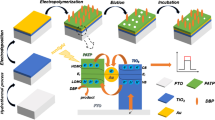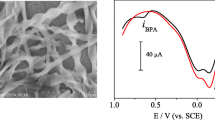Abstract
A novel molecular imprint photoelectrochemical (PEC) sensor has been prepared based on oriented single-crystalline TiO2 nanoarray (TNA) material for sensitive detection of diclofenac (DCF). The TNA obtained by the one-step hydrothermal method was characterized by XRD, SEM, and TEM. Polypyrrole film was formed on the TNA by electrochemical method, and DCF was imprinted on the polymer film as the template molecule. After the removal of DCF, there appeared lots of specific recognition sites that matched template molecules. The experimental results demonstrated that the constructed PEC sensor has good sensitivity and selectivity for the detection of DCF, which can be attributed to the high photoelectric conversion efficiency of TNA and the high selectivity of molecular imprinting technology. The fabricated PEC sensor showed a wide detection range (0.05–1000 μM) and a low limit of detection (0.0034 μM) for DCF, as well as good repeatability and stability. The proposed PEC sensor provided an effective strategy in the monitoring of environmental pollutants.
Graphical abstract






Similar content being viewed by others
References
Okoth OK, Yan K, Feng J, Zhang J (2018) Label-free photoelectrochemical aptasensing of diclofenac based on gold nanoparticles and graphene-doped CdS. Sens Actuators, B Chem 256:334–341. https://doi.org/10.1016/j.snb.2017.10.089
Xu H, Zhu S, Xia M, Wang F (2021) Rapid and efficient removal of diclofenac sodium from aqueous solution via ternary core-shell CS@PANI@LDH composite: experimental and adsorption mechanism study. J Hazard Mater 402:123815. https://doi.org/10.1016/j.jhazmat.2020.123815
Wang C, Jiang T, Zhao K, Deng A, Li J (2019) A novel electrochemiluminescent immunoassay for diclofenac using conductive polymer functionalized graphene oxide as labels and gold nanorods as signal enhancers. Talanta 193:184–191. https://doi.org/10.1016/j.talanta.2018.09.103
Nakhaei JM, Jamali MR, Sohrabnezhad S, Rahnama R (2020) Solvent-Assisted dispersive solid phase extraction of diclofenac from human serum and pharmaceutical tablets quantified by high-performance liquid chromatography. Microchem J 152:104260. https://doi.org/10.1016/j.microc.2019.104260
Agüera A, Mezcua M, Mocholí F, Vargas-Berenguel A, Fernández-Alba AR (2006) Application of gas chromatography-hybrid chemical ionization mass spectrometry to the analysis of diclofenac in wastewater samples. J Chromatogr A 1133(1):287–292. https://doi.org/10.1016/j.chroma.2006.08.017
Jin W, Zhang J (2000) Determination of diclofenac sodium by capillary zone electrophoresis with electrochemical detection. J Chromatogr A 868(1):101–107. https://doi.org/10.1016/S0021-9673(99)01149-8
Arancibia JA, Boldrini MA, Escandar GM (2000) Spectrofluorimetric determination of diclofenac in the presence of α-cyclodextrin. Talanta 52(2):261–268. https://doi.org/10.1016/S0039-9140(00)00338-6
Gao P, Wang H, Li P, Gao W, Zhang Y, Chen J, Jia N (2018) In-site synthesis molecular imprinting Nb2O5-based photoelectrochemical sensor for bisphenol A detection. Biosens Bioelectron 121:104–110. https://doi.org/10.1016/j.bios.2018.08.070
Ha T-J, Hong M-H, Park C-S, Park H-H (2013) Gas sensing properties of ordered mesoporous TiO2 film enhanced by thermal shock induced cracking. Sens Actuators, B Chem 181:874–879. https://doi.org/10.1016/j.snb.2013.02.093
Lou XW, Deng D, Lee JY, Feng J, Archer LA (2008) Self-supported formation of needlelike Co3O4 nanotubes and their application as lithium-ion battery electrodes. Adv Mater 20(2):258–262. https://doi.org/10.1002/adma.200702412
Shi Y, Guo B, Corr SA, Shi Q, Hu Y-S, Heier KR, Chen L, Seshadri R, Stucky GD (2009) Ordered mesoporous metallic MoO2 materials with highly reversible lithium storage capacity. Nano Lett 9(12):4215–4220. https://doi.org/10.1021/nl902423a
Song X, Gao L (2008) Facile synthesis and hierarchical assembly of hollow nickel oxide architectures bearing enhanced photocatalytic properties. The Journal of Physical Chemistry C 112(39):15299–15305. https://doi.org/10.1021/jp804921g
Bashiri R, Samsudin MFR, Mohamed NM, Suhaimi NA, Ling LY, Sufian S, Kait CF (2020) Influence of growth time on photoelectrical characteristics and photocatalytic hydrogen production of decorated Fe2O3 on TiO2 nanorod in photoelectrochemical cell. Appl Surf Sci 510:145482. https://doi.org/10.1016/j.apsusc.2020.145482
Meng A, Zhang L, Cheng B, Yu J (2019) TiO2–MnOx–Pt hybrid multiheterojunction film photocatalyst with enhanced photocatalytic CO2-reduction activity. ACS Appl Mater Interfaces 11(6):5581–5589. https://doi.org/10.1021/acsami.8b02552
Welch EC, Powell JM, Clevinger TB, Fairman AE, Shukla A (2021) Advances in biosensors and diagnostic technologies using nanostructures and nanomaterials. Adv Func Mater 31(44):2104126. https://doi.org/10.1002/adfm.202104126
Xu J, Zhao C, Niu K, Gao Z, Song Y-Y (2021) Renewable photoelectrochemical cytosensing platform for rapid capture and detection of circulating tumor cells. Anal Chim Acta 1142:1–9. https://doi.org/10.1016/j.aca.2020.10.049
Krivitsky V, Hsiung L-C, Lichtenstein A, Brudnik B, Kantaev R, Elnathan R, Pevzner A, Khatchtourints A, Patolsky F (2012) Si nanowires forest-based on-chip biomolecular filtering, separation and preconcentration devices: nanowires do it all. Nano Lett 12(9):4748–4756. https://doi.org/10.1021/nl3021889
Liu B, Deng D, Lee JY, Aydil ES (2010) Oriented single-crystalline TiO2 nanowires on titanium foil for lithium ion batteries. J Mater Res 25(8):1588–1594. https://doi.org/10.1557/jmr.2010.0204
Shi T, Wen Z, Ding L, Liu Q, Guo Y, Ding C, Wang K (2019) Visible/near-infrared light response VOPc/carbon nitride nanocomposites: VOPc sensitizing carbon nitride to improve photo-to-current conversion efficiency for fabricating photoelectrochemical diclofenac aptasensor. Sens Actuators, B Chem 299:126834. https://doi.org/10.1016/j.snb.2019.126834
Yang X, Gao Y, Ji Z, Zhu L-B, Yang C, Zhao Y, Shu Y, Jin D, Xu Q, Zhao W-W (2019) Dual functional molecular imprinted polymer-modified organometal lead halide perovskite: synthesis and application for photoelectrochemical sensing of salicylic acid. Anal Chem 91(15):9356–9360. https://doi.org/10.1021/acs.analchem.9b01739
Cheng X, Shang Y, Cui Y, Shi R, Zhu Y, Yang P (2020) Enhanced photoelectrochemical and photocatalytic properties of anatase-TiO2(B) nanobelts decorated with CdS nanoparticles. Solid State Sci 99:106075. https://doi.org/10.1016/j.solidstatesciences.2019.106075
Sutiono H, Tripathi AM, Chen H-M, Chen C-H, Su W-N, Chen L-Y, Dai H, Hwang B-J (2016) Facile synthesis of [101]-oriented rutile TiO2 nanorod array on FTO substrate with a tunable anatase–rutile heterojunction for efficient solar water splitting. ACS Sustainable Chemistry & Engineering 4(11):5963–5971. https://doi.org/10.1021/acssuschemeng.6b01066
Khan MM, Ansari SA, Amal MI, Lee J, Cho MH (2013) Highly visible light active Ag@TiO2 nanocomposites synthesized using an electrochemically active biofilm: a novel biogenic approach. Nanoscale 5(10):4427–4435. https://doi.org/10.1039/c3nr00613a
Madhavi V, Kondaiah P, Ghosh M, Rao G M (2020) Hydrogen plasma-treated 1D/3D TiO2 nanorod array photoanode for efficient photoelectrochemical water splitting. Ceramics International 46 (11, Part A): 17791–17799. https://doi.org/10.1016/j.ceramint.2020.04.085
Yuan J, Li C, Li T, Jing M, Yuan W, Li CM (2020) Remarkably promoted photoelectrochemical water oxidation on TiO2 nanowire arrays via polymer-mediated self-assembly of CoOx nanoparticles. Sol Energy Mater Sol Cells 207:110349. https://doi.org/10.1016/j.solmat.2019.110349
Mostafavi M, Yaftian MR, Piri F, Shayani-Jam H (2018) A new diclofenac molecularly imprinted electrochemical sensor based upon a polyaniline/reduced graphene oxide nano-composite. Biosens Bioelectron 122:160–167. https://doi.org/10.1016/j.bios.2018.09.047
Li W, Chen N, Zhu Y, Shou D, Zhi M, Zeng X (2019) A nanocomposite consisting of an amorphous seed and a molecularly imprinted covalent organic framework shell for extraction and HPLC determination of nonsteroidal anti-inflammatory drugs. Microchim Acta 186(2):76. https://doi.org/10.1007/s00604-018-3187-6
Pei Q, Qian R (1991) Protonation and deprotonation of polypyrrole chain in aqueous solutions. Synth Met 45(1):35–48. https://doi.org/10.1016/0379-6779(91)91845-2
Zhao D, Zhang Y, Ji S, Lu Y, Bai X, Yin M, Huang C, Jia N (2021) Molecularly imprinted photoelectrochemical sensing based on ZnO/polypyrrole nanocomposites for acrylamide detection. Biosens Bioelectron 173:112816. https://doi.org/10.1016/j.bios.2020.112816
Jiokeng SLZ, Tonle IK, Walcarius A (2019) Amino-attapulgite/mesoporous silica composite films generated by electro-assisted self-assembly for the voltammetric determination of diclofenac. Sens Actuators, B Chem 287:296–305. https://doi.org/10.1016/j.snb.2019.02.038
Mokhtari A, Karimi-Maleh H, Ensafi AA, Beitollahi H (2012) Application of modified multiwall carbon nanotubes paste electrode for simultaneous voltammetric determination of morphine and diclofenac in biological and pharmaceutical samples. Sens Actuators, B Chem 169:96–105. https://doi.org/10.1016/j.snb.2012.03.059
Basiri F, Taei M (2017) Application of spinel-structured MgFe2O4 nanoparticles for simultaneous electrochemical determination diclofenac and morphine. Microchim Acta 184(1):155–162. https://doi.org/10.1007/s00604-016-1995-0
Kashefi-Kheyrabadi L, Mehrgardi MA (2012) Design and construction of a label free aptasensor for electrochemical detection of sodium diclofenac. Biosens Bioelectron 33(1):184–189. https://doi.org/10.1016/j.bios.2011.12.050
Eteya MM, Rounaghi GH, Deiminiat B (2019) Fabrication of a new electrochemical sensor based on AuPt bimetallic nanoparticles decorated multi-walled carbon nanotubes for determination of diclofenac. Microchem J 144:254–260. https://doi.org/10.1016/j.microc.2018.09.009
Okoth OK, Yan K, Liu L, Zhang J (2016) Simultaneous electrochemical determination of paracetamol and diclofenac based on poly(diallyldimethylammonium chloride) functionalized graphene. Electroanalysis 28(1):76–82. https://doi.org/10.1002/elan.201500360
Acknowledgements
We gratefully acknowledge the financial support from the Shanghai Science and Technology Committee (Grant No. 17070503000); Program for Changjiang Scholars and Innovative Research Team in University (IRT_16R49) “111” Innovation and Talent Recruitment Base on Photochemical and Energy Materials and International Joint Laboratory on Resource Chemistry (IJLRC).
Author information
Authors and Affiliations
Corresponding authors
Ethics declarations
Conflict of interest
The authors declare no competing interests.
Additional information
Publisher’s note
Springer Nature remains neutral with regard to jurisdictional claims in published maps and institutional affiliations.
Supplementary Information
Below is the link to the electronic supplementary material.
Rights and permissions
About this article
Cite this article
Bai, X., Gao, W., Zhou, C. et al. Photoelectrochemical determination of diclofenac using oriented single-crystalline TiO2 nanoarray modified with molecularly imprinted polypyrrole. Microchim Acta 189, 90 (2022). https://doi.org/10.1007/s00604-022-05206-8
Received:
Accepted:
Published:
DOI: https://doi.org/10.1007/s00604-022-05206-8




